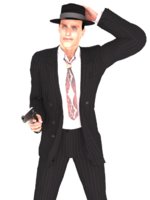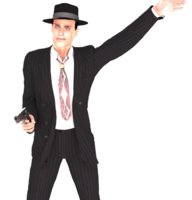I don't find that true at all. Frankly, my Dusk stuff sells as well as the Dawn stuff does.
But, it's really about the fact that so many users are male and they do mostly pinups.
I think the Hivewire Poser base uses male as well as female figures equally, though.
I don't _think_ that's a correct assumption. At least not to go by gallery posts. I see much more of Dawn (and even more of Harry and the cats). I'm sure that your balance has something to do with operating within the HiveWire figure customer base, but I don't think that's the only factor.
Every vendor I've heard talk about it besides you has said that the sales are just _much_ lower. And it makes sense to me, because images with guys get much less traffic than ones with women. That means advertisements and announcements for guys' stuff will get fewer views, and therefore fewer people will even find out about your product.
I'd say that there's tons of interesting things that both are and have happened in men's fashion, but you have to look beyond your average white guys. From my grandfather's time to today, African American men's fashion has been a source of personal expression and pride for all economic classes. From what I've seen here in Texas and back when I lived in NJ, I'd say that was also true in a lot of different Latino communities. And it's not just Japanese men who have interesting fashion, it's most of East Asia. Same goes for African male fashion (I've got some cool pins on Pinterest). Senegal's fashion is apparently getting hot, and what I've seen of examples has been gender balanced or more male. I haven't looked into it, but I won't be surprised if I start looking at Indian male fashion and finding some awesome designs. I already know from clothing research that Arabic and Middle Eastern men have some really nice and interesting fashion going on. So if anyone out there would like to make men's clothes, but finds the idea either limiting or uninspiring, I suggest you start looking into different communities for references.
IMHO, there's one huge issue behind the problem of content for men. Almost all of contemporary art is about the visual objectification of women. Sexualization, too, but they're not synonymous. A woman can still be a person and be sexual. But mostly women in art are symbols, and usually visual symbols rather than ones with complexity and depth. Even when a woman is supposed to have the role of hero, she tends to primarily represent a concept (youth, fragility, determination, rebirth, etc.) rather than a type of actor. This can make for really good art, but it means that we ignore all the details that don't make sense if they're real people. Like how they always have time to put on make-up even though they're in the middle of the woods or in a post-apocalyptic dystopia. While most male actors' aesthetics revolve around what they're doing, most female actors' aesthetics revolve around how they're supposed to make their viewers feel. And the typical viewer is generally assumed to be straight and male.
What customers say they want for men in their art tends to be both specific and detailed. They suddenly start talking about functional, real world considerations. Like how the zippers work or where the pockets should be or how collars should look. Where men in art tend to be actors with specific character traits, women in art tend to be symbols with a general aesthetic style. There was a time when a handsome (or beautiful) male form was used to represent sorrow, joy, youth, freedom, and other concepts as well as a female one, but that time has passed. Our visual vocabulary is limited almost entirely to young women with a specific look.
I think if you hit the niche audience right, brand yourself just right, and generally find the right path business-wise, you can do well with male products. But you have a lot more freedom and flexibility when making things for female characters. And it's a lot easier to make something that will please a wide range of artists.
Also, vendors are in the same community everyone else is. We're influenced by the same media. It's just as unlikely for us to use the male form fluently in our visual vocabulary as it is any other artist in the community.

 )
)


